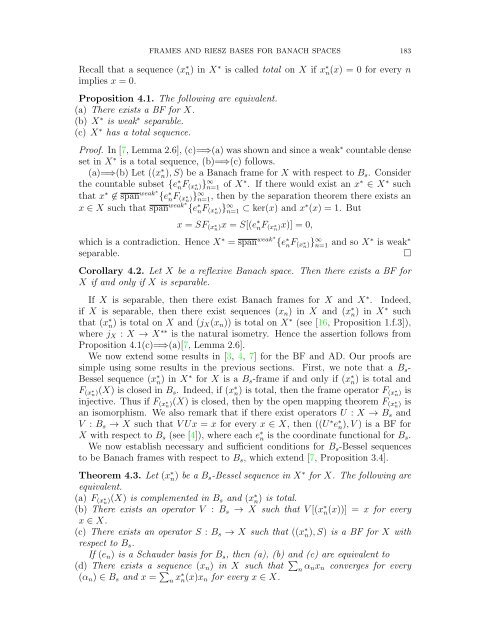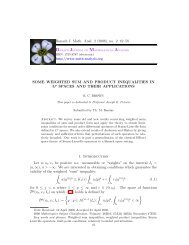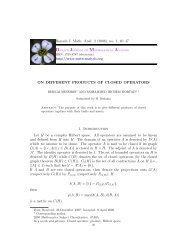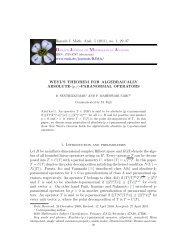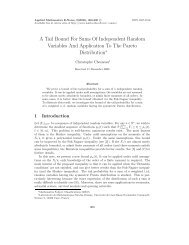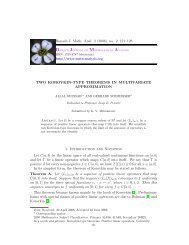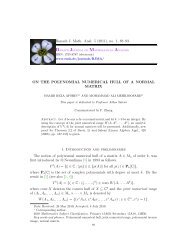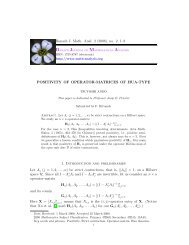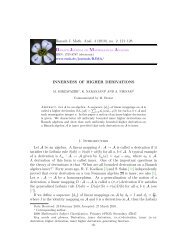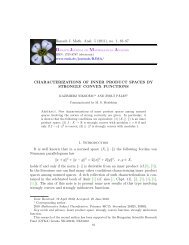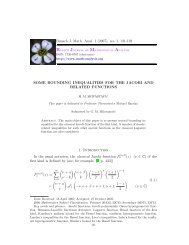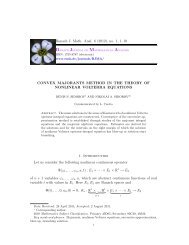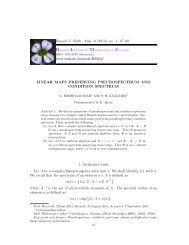Frames and Riesz bases for Banach spaces, and Banach spaces of ...
Frames and Riesz bases for Banach spaces, and Banach spaces of ...
Frames and Riesz bases for Banach spaces, and Banach spaces of ...
- No tags were found...
You also want an ePaper? Increase the reach of your titles
YUMPU automatically turns print PDFs into web optimized ePapers that Google loves.
FRAMES AND RIESZ BASES FOR BANACH SPACES 183Recall that a sequence (x ∗ n) in X ∗ is called total on X if x ∗ n(x) = 0 <strong>for</strong> every nimplies x = 0.Proposition 4.1. The following are equivalent.(a) There exists a BF <strong>for</strong> X.(b) X ∗ is weak ∗ separable.(c) X ∗ has a total sequence.Pro<strong>of</strong>. In [7, Lemma 2.6], (c)=⇒(a) was shown <strong>and</strong> since a weak ∗ countable denseset in X ∗ is a total sequence, (b)=⇒(c) follows.(a)=⇒(b) Let ((x ∗ n), S) be a <strong>Banach</strong> frame <strong>for</strong> X with respect to B s . Considerthe countable subset {e ∗ nF (x ∗ n )} ∞ n=1 <strong>of</strong> X ∗ . If there would exist an x ∗ ∈ X ∗ suchthat x ∗ ∉ span weak∗ {e ∗ nF (x ∗ n )} ∞ n=1, then by the separation theorem there exists anx ∈ X such that span weak∗ {e ∗ nF (x ∗ n )} ∞ n=1 ⊂ ker(x) <strong>and</strong> x ∗ (x) = 1. Butx = SF (x ∗ n )x = S[(e ∗ nF (x ∗ n )x)] = 0,which is a contradiction. Hence X ∗ = span weak∗ {e ∗ nF (x ∗ n )} ∞ n=1 <strong>and</strong> so X ∗ is weak ∗separable.□Corollary 4.2. Let X be a reflexive <strong>Banach</strong> space. Then there exists a BF <strong>for</strong>X if <strong>and</strong> only if X is separable.If X is separable, then there exist <strong>Banach</strong> frames <strong>for</strong> X <strong>and</strong> X ∗ . Indeed,if X is separable, then there exist sequences (x n ) in X <strong>and</strong> (x ∗ n) in X ∗ suchthat (x ∗ n) is total on X <strong>and</strong> (j X (x n )) is total on X ∗ (see [16, Proposition 1.f.3]),where j X : X → X ∗∗ is the natural isometry. Hence the assertion follows fromProposition 4.1(c)=⇒(a)[7, Lemma 2.6].We now extend some results in [3, 4, 7] <strong>for</strong> the BF <strong>and</strong> AD. Our pro<strong>of</strong>s aresimple using some results in the previous sections. First, we note that a B s -Bessel sequence (x ∗ n) in X ∗ <strong>for</strong> X is a B s -frame if <strong>and</strong> only if (x ∗ n) is total <strong>and</strong>F (x ∗ n )(X) is closed in B s . Indeed, if (x ∗ n) is total, then the frame operator F (x ∗ n ) isinjective. Thus if F (x ∗ n )(X) is closed, then by the open mapping theorem F (x ∗ n ) isan isomorphism. We also remark that if there exist operators U : X → B s <strong>and</strong>V : B s → X such that V Ux = x <strong>for</strong> every x ∈ X, then ((U ∗ e ∗ n), V ) is a BF <strong>for</strong>X with respect to B s (see [4]), where each e ∗ n is the coordinate functional <strong>for</strong> B s .We now establish necessary <strong>and</strong> sufficient conditions <strong>for</strong> B s -Bessel sequencesto be <strong>Banach</strong> frames with respect to B s , which extend [7, Proposition 3.4].Theorem 4.3. Let (x ∗ n) be a B s -Bessel sequence in X ∗ <strong>for</strong> X. The following areequivalent.(a) F (x ∗ n )(X) is complemented in B s <strong>and</strong> (x ∗ n) is total.(b) There exists an operator V : B s → X such that V [(x ∗ n(x))] = x <strong>for</strong> everyx ∈ X.(c) There exists an operator S : B s → X such that ((x ∗ n), S) is a BF <strong>for</strong> X withrespect to B s .If (e n ) is a Schauder basis <strong>for</strong> B s , then (a), (b) <strong>and</strong> (c) are equivalent to(d) There exists a sequence (x n ) in X such that ∑ n α nx n converges <strong>for</strong> every(α n ) ∈ B s <strong>and</strong> x = ∑ n x∗ n(x)x n <strong>for</strong> every x ∈ X.


